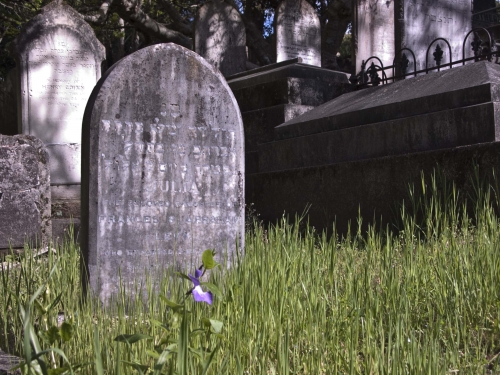

Epitaphs on headstones are a repository of memories and poignant stories. Those found within historic Napier Cemetery (opened 1855 - closed 1917) give a sense European life in late nineteenth/early twentieth century Hawke’s Bay. The words and sentiments are of their time and may seem unusual, strange or even inappropriate in today’s world.
Cemetery is Latin for ‘place of repose’ or ‘sleeping room’. Napier Cemetery is a quiet, peaceful place with only birdsong to accompany the visitor as they wander through the maze of headstones. Passer-by’s may pause in front of a particular gravestone, drawn perhaps by the poignancy of etched words; bend down to see the sometimes indecipherable letters or brush away layers of dirt and leaves to see more of what is written.
The language may captivate or evoke a deep emotional response: words glorifying god; portraying a life cut short; giving a glimpse of a life story; and most significantly, dignified words describing the sense of anguish and heartbreak the loss of a loved one represents.
Snippets of religious figures are documented: William Leonard Williams’ grave states he was the “Third Bishop of Waiapu. Born January 22 1829, at the first baptism of Maori infants. Entered into life August 24 1916 after 63 years work among the Maoris and Europeans of this diocese.”
Reverend William Colenso, “Born in Penzance 17th Nov 1811, was the first printer in these islands, and the first missionary in Hawke’s Bay. Died at Napier Feb. 10th 1899, aged 88 years.” Friend and colleague, Henry Hill, wrote of Colenso’s funeral: “The scene was sad, and withal beautiful. An old man full of years and honours was borne to his last resting place. Yet no wife, no child, no relative was there to mourn his passing.”
Several graves relate directly to the New Zealand Wars. The words are raw and succinct: “Alice Sweetman Wilson. One of the victims of the massacre at Poverty Bay on 10 Nov. 1868, who died of her wounds at Napier 17 Dec. 1868, aged 30 years. Wife of Capt. James Wilson who died 10 Nov, 1868, aged 34 years along with 3 of their 4 children.”
Captain John Chapman St George “who died whilst gallantly leading the attack on Te Kooti’s pah, Porere, Roto Aira, 4 October 1869 in the 29th year of his age. His remains were brought from Roto Aira and re-interred beneath this stone on 27 April 1870.”
Family graves memorialise sons killed serving overseas during World War I. “Gunner Thomas E L Moore wounded at Gallipoli, Aug 11th 1915, died at sea, Aug 15th 1915. Dulce et decorum est pro patria more” translated as “it is sweet and fitting to die for the motherland/fatherland.”
In the 1800s, death by drowning was dubbed “the New Zealand death”. Rhoda Farrar and Mary Simmons aged 14 and 15 years respectively, both drowned on 20 January 1876 at East Clive: “Two merry creatures young and gay; the watery elements swept away; never so merry as on that day; when almighty God, called both away.”
Dastardly storms and desperate moments are referenced. Archibald Waddell “met his death by the wreck of the Boojum” trying to rescue people from the floundering Northumberland, anchored in Ahuriri. Alex Morris perished on the SS Manipouri when: “descending the ships hold he quenched a fire caused by nitric acid the deadly fumes of which occasioned his death, February 26 1886.”
Every child’s death is a genuine and heartbreaking loss, making epitaphs to children particularly touching. The parents of William Yates, who died aged two days on 16 January 1900, inscribed on his headstone: “God needed one more angel child amid his shining band and so he bent with loving smile and clasped our darling’s hand.”
On the boundary of the cemetery, next to the botanical gardens, is a lonely grave belonging to William Rickard, who died 26 February 1907, aged 9 years. His epitaph reads: “We shall miss him when the flowers come in the garden where he played; we shall miss him more by the fireside, when the flowers have all decayed; we shall see his toys and his empty chair and the horse he used to ride; and they will speak with a silent speech of our little boy that died.”
If you’re keen to learn more about the history of Napier Cemetery and those interred within, there are three tours left this summer one tomorrow, and two in March. Bookings are essential and are done through Eventfinda on MTG Hawke’s Bay website. The first walk takes place tomorrow, Sunday 26 January, at 2.00pm.
WHAT’S ON
26 January 2020
Disclaimers and Copyright
While every endeavour has been taken by the MTG Hawke's Bay to ensure that the information on this website is
accurate and up to date, MTG Hawke's Bay shall not be liable for any loss suffered through the use, directly or
indirectly, of information on this website. Information contained has been assembled in good faith.
Some of the information available in this site is from the New Zealand Public domain and supplied by relevant
government agencies. MTG Hawke's Bay cannot accept any liability for its accuracy or content.
Portions of the information and material on this site, including data, pages, documents, online
graphics and images are protected by copyright, unless specifically notified to the contrary. Externally sourced
information or material is copyright to the respective provider.
© MTG Hawke's Bay - https://www.mtghawkesbay.com / +64 6 835 7781 / info@mtghawkesbay.com